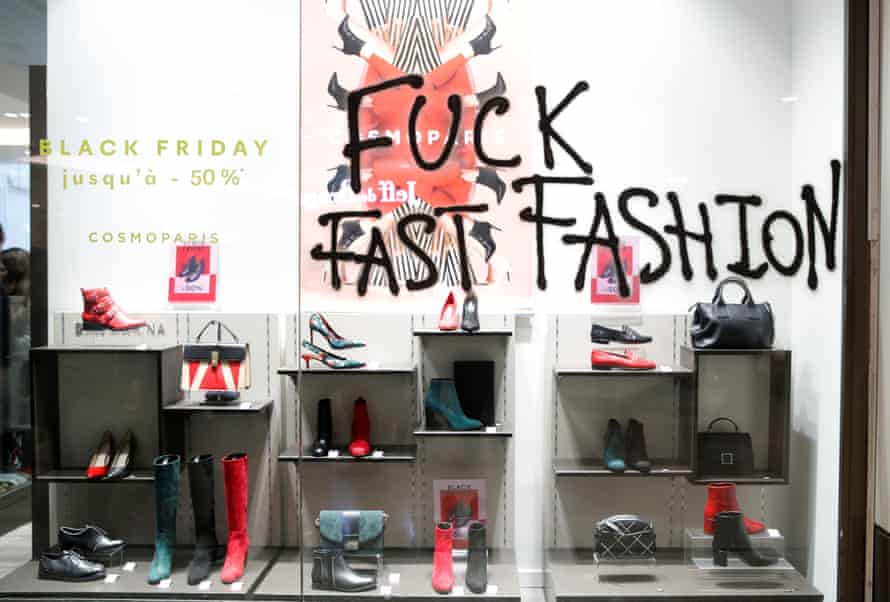
Fast fashion is engineered to fit in with busy lives. Low prices invite low maintenance (cheaper and quicker to chuck than to launder and iron), low risk – or so it appears (buy in haste, no need to repent if it doesn’t look right), and the convenience is unrivalled (swipe, click and answer the door).
The pressure to look on trend is capitalised on by thousands of affiliates and celebrities who have the ears and eyes of millions of followers on social media.
The enticement to buy is immense and, for many, irresistible. Aggressive marketing combined with the use of algorithms, which scan social media for micro trends, enable brands to cut production to as little as 10 days. The designer is obsolete and, instead, engineers and sophisticated software allow the production of clothes that are fit for the screen, designed for obsolescence, destined for landfill.
Shein is at the forefront of this new business model. Last week, the e-commerce giant was valued at $100bn, making it worth as much as Zara and H&M combined. Shein has risen from relative obscurity to dominate this market, taking revenue from $2bn in 2018 to $15.7bn in 2021. Its model of manufacturing garments, plus our demand for them, means it churns out up to a staggering 10,000 new products a day. The constant, timed mark-downs, shown in hours and minutes, perpetuate the idea that you need to buy now and can’t wear anything twice.
The Guangzhou-based business was founded in 2008 by Chris Xu and has 7,000 employees. Predicated on the “test and repeat” model, made famous by Inditex and H&M, just 6% of Shein’s inventory remains in stock for more than 90 days. It relies on third-party suppliers in China to produce small batches of clothes, about 50-100 per item. If an item does well, more batches are commissioned; if not, the lines are immediately discontinued. Shein ships to 250 countries – a sobering thought when you consider the emissions not just of deliveries but also returns. Most returns end up in landfill because it costs more to put them back in circulation. Shein overtook Amazon as the most downloaded shopping app in the US last year, underlining how its use of digital marketing has helped it overtake rivals so adeptly.
Shein’s meteoric rise is taking fast fashion, an already resource-depleting model in environmental and social terms, to fresh depths, carving out a new category: ultra-fast fashion. In a week when we have also seen the Intergovernmental Panel on Climate Change lay out the stark realities of the climate emergency – and with a growing number of people purporting to care deeply about the future of the planet – the success of Shein is somewhat of a paradox.
Its extraordinary rise in popularity comes despite a poor social and environmental record and controversial practices, from allegedly ripping off designs from small labels to producing swastika necklaces, not to mention the labour conditions found among its suppliers.
The Shein valuation has sharply divided opinion and we would do well to consider why this is so. Some herald it as inclusive, due to its price points, and others call it out for the impact of its practices on life and lives. We should be under no illusions: ultra-fast fashion has little to do with democratisation and much more to do with profit and wealth for those at the top.

It is not those on low incomes who drive this industry. The biggest customer base is people with substantial disposable incomes, which raises the question: where did our fashion sense go so wrong?
This dominant model of fashion is untenable. There are much better ways of making a living and representing yourself than through clothes that are environmentally and socially destructive. There is a burgeoning (but not yet fully representative) array of fashion that does not subscribe to this model. Designers such as Bethany Williams embody fashion with integrity. Secondhand, resale and rental are rapidly growing, but rather than replacing at least part of the dominant system, people are still tempted back to these brands, which perpetuate such a warped image of prosperity.
Governments continue to offer a licence to do harm, endorsing poorly regulated, exploitative practices that don’t count the costs incurred in pollution, emissions (fashion emits more than international aviation and shipping combined), soil degradation, biodiversity loss and human wellbeing. This lack of regulation and incentives to grow infinitely are an absurdity on a finite planet. Fast fashion is far from cheap – someone, somewhere is paying the real price. Whether they are workers in Leicester being paid £3.50 an hour in sweatshop conditions, or farmers in India dying from dangerous chemicals in the production of cotton – collectively and individually, we are all paying.
Working with students at London College of Fashion, UAL, we set out to create propositions in fashion that can transform this model. The industry was designed to maximise profit at any cost, so radical action must be taken to rebuild it to include equity, racial and climate justice. We apply our creative skills in places where we can make the biggest difference, from refugee camps in Jordan, to communities in east London. Fashion is something that we all take part in. It’s a social, creative, economic and cultural set of activities that can contribute to the world, not just take from it.
We need to take away the licence to do harm. Last week the European Environmental Agency announced a crackdown on fast fashion. The UK government should follow suit. It will take governments, universities and businesses working together to fulfil our collective responsibility to protect our planet and industry for future generations. Nothing less than radical change is required to avoid 4C warming. There is no life, let alone fashion, in that world.
Professor Dilys Williams is director of the Centre for Sustainable Fashion at the London College of Fashion, UAL, www.sustainable-fashion.com



